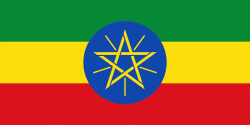Hagere Mariam (Hagere Maryam)
Bule Hora (Bulee Horaa; Amharic: ሀገረ ማርያም) is a town in southern Oromia Region, Ethiopia. Located on the paved Addis Ababa-Moyale highway, in the West Guji Zone, it is the largest town in this zone mainly inhabited by the Guji Oromo. It has a latitude and longitude of 5.58333°N, 38.25°W and an altitude of 1716 meters above sea level.
An orthodox church dedicated to Mary (Mariam) was built in the early 1900. Bule Hora name changed Hagere Mariam and introduced by the Amhara sometimes before 1934. In 1936 Kenyazmach Tekle Giyorgis, a nephew of Ras Desta Damtew, was the chief of the town. It was occupied by the Italians on 22 July 1936, who renamed it "Alghe". They rebuilt the village and constructed a fort nearby; the Italians also bestowed honors and powers to a local Guji chief.
In the following decades, Bule Hora became isolated: a group of Swedish missionaries traveling to the Burji in March 1950 brought the first motorized vehicles seen in the town since the Italian occupation. A Norwegian Evangelical Mission was established at Hagere Mariam on 15 August of the same year, with the goal of reaching the Guji. Its founding leader was Karl Bogetvedt who worked from a little rented house inside the town, with dwelling, school and clinic in the same building. The mission station in Hagere Mariam continued into the 1980s. Guji zone is known by Geda System, which is thought to be source of democracy.
An orthodox church dedicated to Mary (Mariam) was built in the early 1900. Bule Hora name changed Hagere Mariam and introduced by the Amhara sometimes before 1934. In 1936 Kenyazmach Tekle Giyorgis, a nephew of Ras Desta Damtew, was the chief of the town. It was occupied by the Italians on 22 July 1936, who renamed it "Alghe". They rebuilt the village and constructed a fort nearby; the Italians also bestowed honors and powers to a local Guji chief.
In the following decades, Bule Hora became isolated: a group of Swedish missionaries traveling to the Burji in March 1950 brought the first motorized vehicles seen in the town since the Italian occupation. A Norwegian Evangelical Mission was established at Hagere Mariam on 15 August of the same year, with the goal of reaching the Guji. Its founding leader was Karl Bogetvedt who worked from a little rented house inside the town, with dwelling, school and clinic in the same building. The mission station in Hagere Mariam continued into the 1980s. Guji zone is known by Geda System, which is thought to be source of democracy.
Map - Hagere Mariam (Hagere Maryam)
Map
Country - Ethiopia
 |
 |
| Flag of Ethiopia | |
Anatomically modern humans emerged from modern-day Ethiopia and set out to the Near East and elsewhere in the Middle Paleolithic period. Southwestern Ethiopia has been proposed as a possible homeland of the Afroasiatic language family. In 980 BCE, the Kingdom of D'mt extended its realm over Eritrea and the northern region of Ethiopia, while the Kingdom of Aksum maintained a unified civilization in the region for 900 years. Christianity was embraced by the kingdom in 330, and Islam arrived by the first Hijra in 615. After the collapse of Aksum in 960, a variety of kingdoms, largely tribal confederations, existed in the land of Ethiopia. The Zagwe dynasty ruled the north-central parts until being overthrown by Yekuno Amlak in 1270, inaugurating the Ethiopian Empire and the Solomonic dynasty, claimed descent from the biblical Solomon and Queen of Sheba under their son Menelik I. By the 14th century, the empire grew in prestige through territorial expansion and fighting against adjacent territories; most notably, the Ethiopian–Adal War (1529–1543) contributed to fragmentation of the empire, which ultimately fell under a decentralization known as Zemene Mesafint in the mid-18th century. Emperor Tewodros II ended Zemene Mesafint at the beginning of his reign in 1855, marking the reunification and modernization of Ethiopia.
Currency / Language
| ISO | Currency | Symbol | Significant figures |
|---|---|---|---|
| ETB | Ethiopian birr | Br | 2 |
| ISO | Language |
|---|---|
| AM | Amharic language |
| EN | English language |
| OM | Oromo language |
| SO | Somali language |
| TI | Tigrinya language |















